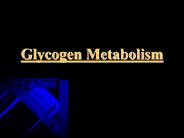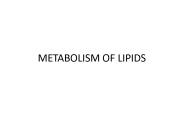Metabolism PowerPoint PPT Presentations
All Time
Recommended
BCH 1002 Biochemical Aspects of Health and Disease BIOMOLECULES AND METABOLISM 3. Metabolism and Its Control Prof. K. M. Chan Dept. of Biochemistry
| PowerPoint PPT presentation | free to view
Metabolism & Enzymes
| PowerPoint PPT presentation | free to download
Metabolism Chapter 25 Glucose Metabolism From one molecule of Glucose We can get 36 or 38 total ATP s (32 to 34 from Electron Transport) Other Metabolic Pathways ...
| PowerPoint PPT presentation | free to view
metabolism you must know the key role of atp in energy coupling that enzymes work by lowering the energy of activation the catalytic cycle of an enzyme that ...
| PowerPoint PPT presentation | free to download
Metabolism The sum of all chemical reactions within the living cells
| PowerPoint PPT presentation | free to download
Metabolism Regulation of food intake food intake is motivated behavior depends on the interplay of complex processes in addition to the need for nutritients, many ...
| PowerPoint PPT presentation | free to view
METABOLISM Thyroid Gland is located in front of the trachea. It produces hormones: Thyroxine (T4) Triiodothyronine (T3) T4 and T3 regulate body metabolism and
| PowerPoint PPT presentation | free to view
Metabolism II Nearly all of the energy needed by the human body is provided by the oxidation of carbohydrates and lipids. Whereas carbohydrates provide a readily ...
| PowerPoint PPT presentation | free to download
Metabolism The process in which your body gets energy from the food you eat (How fast your body burns / stores the food you eat) Basal Metabolism The minimum amount ...
| PowerPoint PPT presentation | free to download
Metabolism Anabolism Catabolism Energy Capture Oxidation Electron loss Reduction Electron gain Redox Coupled reactions Metabolic Lifestyles AUTOTROPHY Photoautotroph ...
| PowerPoint PPT presentation | free to download
XENOBIOTIC METABOLISM ... Most importance enzyme in xenobiotic metabolism ... Activity of xenobiotic metabolizing enzymes can be vary between individual ...
| PowerPoint PPT presentation | free to view
Metabolism Metabolism The sum of all cell activity How cells make energy from the food we eat to conduct body processes. The process starts with digestion.
| PowerPoint PPT presentation | free to view
Metabolism Metabolism Metabolism = anabolism + catabolism In a reaction, bonds between reactants break down and bonds between products form. Energy is absorbed when ...
| PowerPoint PPT presentation | free to view
Metabolism Chapter 19 The Action of Leptin Leptin crosses the BBB To affect NTs released by neurons in the arcuate nucleus Influences other hypothalamic nuclei Which ...
| PowerPoint PPT presentation | free to view
metabolism glucose is the principle substrate used to form atp glycolysis occurs in cytoplasm anaerobic highlights of glycoylysis two atp converted to adp four adp ...
| PowerPoint PPT presentation | free to download
METABOLISM Lipolysis breakdown of lipids triglyceride 2 F.A.s + glycerol reaction is hydrolysis catalyzed by lipases epinephrine & norepinephrine stimulate breakdown ...
| PowerPoint PPT presentation | free to view
Lipid soluble compounds reabsorbed (renal tubules) ... Metabolism then proceeds in apparent first order fashion. ... Intermediate blends among other ethnic groups ...
| PowerPoint PPT presentation | free to view
Metabolism consists of literally hundreds of enzymatic reactions organized into ... in catabolism and anabolism citric acid cycle- Such pathways are amphibolic ...
| PowerPoint PPT presentation | free to view
Metabolism- The way your body burns up all of the calories from the food that you eat. Metabolic Rate- Speed at which your body burns up calories ...
| PowerPoint PPT presentation | free to view
Glycogen Metabolism
| PowerPoint PPT presentation | free to download
Chapter 17 Metabolism An Overview Biochemistry by Reginald Garrett and Charles Grisham Metabolism Metabolism represents the sum of the chemical changes that ...
| PowerPoint PPT presentation | free to view
Glycogen metabolism The metabolism of glycogen in animals Glycogenesis: formation of glycogen (de novo or enlarge) Glycogenolysis: mobolizing glycogen Dietary ...
| PowerPoint PPT presentation | free to view
Metabolism II Nearly all of the energy needed by the human body is provided by the oxidation of carbohydrates and lipids. Whereas carbohydrates provide a readily ...
| PowerPoint PPT presentation | free to download
Lindsey Bily Anatomy & Physiology Metabolism All the reactions that occur in the body Cell Metabolism is all the reactions that occur in the cell.
| PowerPoint PPT presentation | free to view
Cell metabolism Breakdown of glucose Without oxygen: anaerobic catabolism Location: cytoplasm Into lactic acid Process called glycolysis Produces little ATP GLUCOSE ...
| PowerPoint PPT presentation | free to view
Bacterial Metabolism Introduction Metabolism ... ATP generated via chemiosmosis ( proton pump ) and ATP synthase Photo - light energy from photosynthesis, ...
| PowerPoint PPT presentation | free to download
Blood-Hematopoiesis-Lymphatics Iron Metabolism William F. Kern, M.D. Department of Pathology william-kern@ouhsc.edu
| PowerPoint PPT presentation | free to view
These enzymes metabolize drugs only because the drugs resemble the natural compound ... SSRI antidepressants) Drug Metabolism - Reduction Azo-reduction: Nitro ...
| PowerPoint PPT presentation | free to view
Muscle Metabolism Aerobic respiration: produces large amounts of ATP but requires O2 to function, waste products: water, CO2 Anaerobic fermentation: produces small ...
| PowerPoint PPT presentation | free to download
Metabolism Totality of an organism s chemical processes Catabolic pathways (release energy) Breakdown Respiration Anabolic pathway Build up Photosynthesis ...
| PowerPoint PPT presentation | free to view
Metabolism of lipids Course Content Digestion and absorption of lipids Triacylglycerol metabolism Phospholipid metabolism Cholesterol metabolism plasma lipoprotein ...
| PowerPoint PPT presentation | free to view
Biochemistry and Metabolism The course will cover: Enzymes kinetics and control Control of metabolism Control of metabolism is the control of enzyme activity
| PowerPoint PPT presentation | free to view
CARBOHYDRATE METABOLISM Kadek Rachmawati, M.Kes.,Drh CARBOHYDRATE DIGESTION AMYLUM digestion by amylase enzyme Disaccharides digestion Glucose is the most important ...
| PowerPoint PPT presentation | free to view
Lipid metabolism Lipid structure Triglyeride (triacylglycerol) metabolism Lipogenesis Lipolysis FFA oxidation Fat metabolism during exercise Training effects on fat ...
| PowerPoint PPT presentation | free to view
Protein Metabolism Starvation Amino acids released by proteolysis Channeled to the liver for gluconeogenesis Although not all amino acids can be made into glucose ...
| PowerPoint PPT presentation | free to view
Microbial Metabolism Ch 5 Metabolism is the sum of the chemical reactions in an organism. Catabolism is the energy-releasing processes. Anabolism is the energy-using ...
| PowerPoint PPT presentation | free to view
Iron Metabolism & Hypochromic Anemia Yuttana Mundee MYuttana@netscape.net Objectives Iron Metabolism Iron Deficiency Anemia Sideroblastic Anemia Lead Poisoning ...
| PowerPoint PPT presentation | free to view
... family of enzymes Metabolizes a broad range of structurally diverse endogenous and exogenous compounds Structurally related family ... Taxol (cancer drug ...
| PowerPoint PPT presentation | free to view
Protein metabolism By Dr OJ Tsotetsi protein A major component of foods. It is digested firstly in the stomach, and then in the duodenum to dipeptides and amino acid.
| PowerPoint PPT presentation | free to view
BMR and Metabolism What is METABOLISM ... The energy from these compounds can be released for use by the body or stored in body tissues, especially the liver, muscles ...
| PowerPoint PPT presentation | free to view
KETONE BODY METABOLISM Dr.Siddiqui Abdulmoeed Associate Professor of Biochemistry College of Medicine Al-jouf University OBJECTIVES Define ketone bodies.
| PowerPoint PPT presentation | free to view
METABOLISM OF LIPIDS ... bond between fatty acid and other molecules can be hydrolysed using lipases enzyme Phosphoacylglycerols membrane component ...
| PowerPoint PPT presentation | free to download
Introduction to Metabolism Artika Nath Biochemistry School of Health Sciences Objectives We are now going to look at two major questions in Biochemistry How do cells ...
| PowerPoint PPT presentation | free to view
MAMMAMALIAN METABOLISM Integration and Hormonal Regulation Objective Consider the major metabolic pathways in the context of the whole organism Issues with ...
| PowerPoint PPT presentation | free to view
Chapter 5 lipids metabolism LIPIDS Water-insoluble substances that can be extracted from cells by nonpolar organic solvents Characteristics of fat Hydrophobic because ...
| PowerPoint PPT presentation | free to view
Energy and Metabolism Chapter 8
| PowerPoint PPT presentation | free to download
Energy, Enzymes, and Metabolism
| PowerPoint PPT presentation | free to view
Chapter 5: Microbial Metabolism
| PowerPoint PPT presentation | free to view
Chapter 8 Nucleotide Metabolism Chapter 8 Nucleotide Metabolism * Nucleotides are bilding blocks of nucleic acids. They are non-essential nutrients , because they can ...
| PowerPoint PPT presentation | free to view
Microbial Metabolism Enzymes * * * * * * * * * * Oxidative phosphorylation Electrons are transferred from organic compounds through a series of electron carriers to ...
| PowerPoint PPT presentation | free to view
Chapter 13. Drug Metabolism Introduction: the process of drugs in the body includes absorption, distribution, metabolism and elimination. Drug metabolism is also ...
| PowerPoint PPT presentation | free to view
Regulation of Metabolism How does the body know when to increase metabolism? Slow metabolism? What might be some indicators of energy status within the cell?
| PowerPoint PPT presentation | free to view
An Introduction to Metabolism Is the totality of an organism s chemical reactions Arises from interactions between molecules An organism s metabolism transforms ...
| PowerPoint PPT presentation | free to download
Metabolism of Lipoproteins Hyperlipoproteinemia MODERATE RISK SCORE 1 -
| PowerPoint PPT presentation | free to view
Glycogen Metabolism: Glycogenesis and Glycogenolysis. Glycogen synthesis, known as glycogenesis, occurs when glucose concentrations are high. ...
| PowerPoint PPT presentation | free to view
Title: Metabolism: Fueling Cell Growth Author: melliott Last modified by: Your User Name Created Date: 9/4/2005 5:15:01 PM Document presentation format
| PowerPoint PPT presentation | free to download
























































